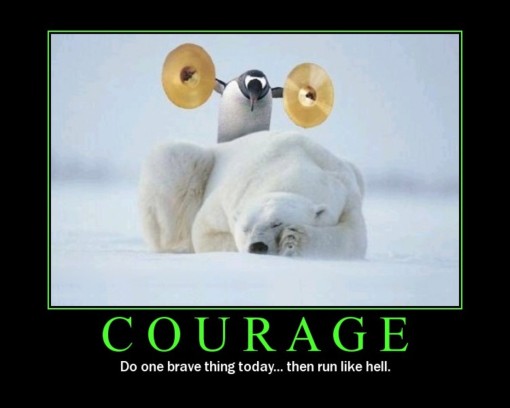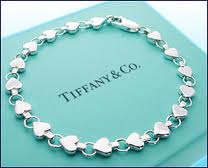 Courage. Now, there’s a word not often used in marketing – though often used in business. We call leaders courageous when they make unpopular decisions, usually internally, that change process significantly enough to create a turnaround. Perhaps to drive costs down, perhaps to drive morale up – but always to make a significant change. In marketing, in my humble opinion, courage is the ability to very clearly identify, select and stick with a target audience.
Courage. Now, there’s a word not often used in marketing – though often used in business. We call leaders courageous when they make unpopular decisions, usually internally, that change process significantly enough to create a turnaround. Perhaps to drive costs down, perhaps to drive morale up – but always to make a significant change. In marketing, in my humble opinion, courage is the ability to very clearly identify, select and stick with a target audience.
I believe those (marketers) who are most courageous are the ones who dare to dabble in the psychology of status – a concept first introduced by Herbert Hyman (1918-1985) in 1942. The premise of the psychology of status is that individuals use groups of reference to evaluate aspects of their lives – both positively and negatively.
The idea, in marketing, is that the brand becomes so deeply a part of the group it is targeting that it becomes representative – it tastes, feels, acts like (insert group here). Think Harley Davidson or Harvard.
It is important to note that positive referencing is very subjective; it changes from person to person. Take for example the difference between two groups: bachelor(ette)s and married (wo)men. Neither group is good or bad, but each conjure up a very specific set of qualities, values and adjectives that may or may not appeal to you. As a marketer, if you choose to target the bachelor(ette) group, you would want to stay away from terms like: long-term commitment, honeymoon, and matching robes… unless, of course, you were making fun of it.
But therein lies the taboo behind courage in marketing. Business is about the bottom line; and we all know that marketing is a cost-centre, not a revenue generator. So, why would we dare go after a single, very defined market, at the risk of pushing away another (and potentially losing revenue opportunities)? Wouldn’t it be better to be all things to all people and build the opportunity to tap into everyone’s wallet? (And, wouldn’t it be better to read 1 book on every subject rather than to specialize and become experts in a few?)
OK – there was a time where appealing to the broadest population possible meant that you would reach people, who might not have been in that “specifically defined audience” but who would spend on your brand. (Remember the days of yore – when mass marketing was the “it” thing…) But in the world of 2010, after a recession that changed how people and businesses invest, is the money spent on the mass appeal worth the few more consumers? More importantly, if you would spend more effectively towards, say, that very clearly defined market, would the others really not spend on your brand?
Let me be clear – targeting a smaller, more defined group within the population is not free. But I genuinely believe that the investment will yield more value (i.e. more return) and compared to a long-term view of investment, the overall spend could be less. I also recognize that success in this requires investment of a different kind – investment in time, because catering to a smaller group requires being part of that group. Enter social media (but that is for another post).
Another point of clarity: mass marketing can still work for some brands: think Coke, Kleenex and McDonald’s. These big brands have been around for years and were created – from the get-go – to reach the mass population. And even they, at times, create product lines or campaigns meant to cater specifically to more finite groups within the masses – but, despite these efforts, are usually recognized for their “being all things to all people” approach.
So, unless you’re working for one of these “big guys” or you’ve just opened the doors to some magically multi-billion dollar grossing business, you need to think about your marketing spend. To do this wisely, I suggest minimalism: usually used in music or visual arts, and is defined as stripping the work down to its basic fundamentals.
Hampton Roads, New Madrid, Delaware Crossing, Sabine Pass, Palmito Ranch and Island No. 10, 1962
How? Here are a few thoughts:
Basic fundamental #1: For whom is your brand built? (eek – proper English, but couldn’t stand the squiggly line on MS Word) Think of groups of reference.
- Pick 1 or 2 (no more) and get to know them deeply.
- Identify the key descriptors for them and make sure you get it. (You can’t target skateboarders if everyone in your boardroom is a “suit”.)
- Live it. Breathe it. Be it.
Basic fundamental #2: Design every single touch point – inside and outside – to be reflective of, and relevant to, the community you want to serve. (If you really want to focus on affluent dog owners in the Greater Toronto Area, you might want to check out Bark & Fitz.)
Basic fundamental #3: Never, ever, ever, ever stray. Building a reputation takes years, destroying it – moments. Stick to your guns!
And, last but not least, which in fact should be first: make sure whoever you’re going to be, whichever group you are a part of, has a few bucks to spend on you… because, in the end, business is about the bottom line.
To wrap up this very long post, which will undoubtedly have a sequel, I’d like to offer a few “kudos” to some companies who have courageous marketers. Each different – from pricing to product to distribution. Each targeting different people unlikely to overlap. Their basic fundamental – they’ve picked a group, they’re focusing their positioning, and they’re succeeding.
- Jones Soda Co. – The beverage for rebels
- Mountain Equipment Coop – The store for real outdoor enthusiasts to get great value on great gear
- Tiffany & Co. – “Since 1837, Tiffany & Co. has been the world’s premier jeweler and America’s house of design.”
Courage and perseverance have a magical talisman, before which difficulties disappear and obstacles vanish into air.
John Quincy Adams





